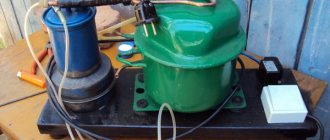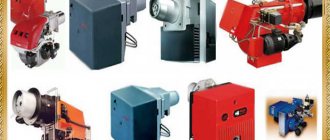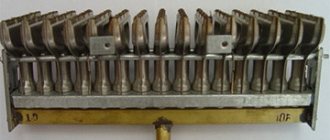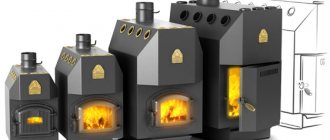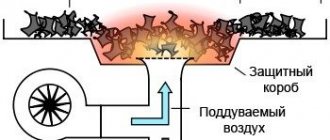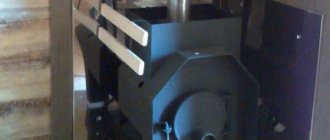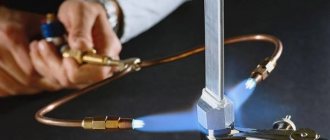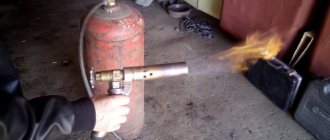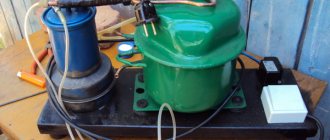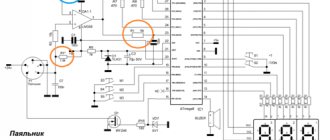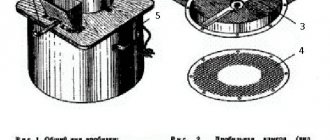In non-gasified settlements, along with solid fuel boilers, liquid fuel (or diesel) boilers are in great demand, since in terms of ease of use they are only slightly inferior to gas heaters.
In order to make the right choice when purchasing such a unit, the user should first of all know something about liquid fuel burners.
What are they, what requirements must they meet and what should be included in the kit? How and from what can a diesel burner be made with your own hands?
Boiler design
A diesel boiler consists of a control unit, a combustion chamber, a diesel burner, a heat exchanger, a filter for filtering fuel, and a chimney.
Control block
needed to adjust the automatic operation of the burner and pump. With its help, you can control the temperature and adjust it depending on weather conditions and your preferred microclimate.
In the combustion chamber
The fuel used for heating is burned. When choosing the appropriate equipment, it is necessary to take into account such an indicator as the coefficient of specific resistance of the combustion chamber.
Diesel burner
needs to be properly configured, since the operation of this element affects the heating of the heating system and how much fuel is required and whether it can be saved.
In the heat exchanger
The coolant heats up. Heating is based on the principle of heat energy exchange in the area between the heat exchanger and the combustion chamber.
Filter
is used to prevent debris and dirt from entering the burner, and the reliability of the entire system depends on how correctly the chimney is installed.
It’s worth noting right away that a heating system using a diesel type, by definition, cannot be cheap
. However, financial costs can be reduced through high-quality insulation of the house, as well as periodic maintenance of installed equipment.
Working principle of the device
The fuel in the lower tank boils after 5 minutes of operation. Oil vapor enters the next compartment, called the burner. There, for better combustion, the steam is enriched with oxygen.
The principle of drip feeding of waste into a bowl (click on the picture to enlarge)
Then, gaseous, liquid and solid substances enter the upper compartment, and from there into the chimney. The highest temperature is in the upper module of the drip furnace.
How to choose
When choosing, you need to pay attention to the following characteristics:
- thermal power;
- mass fuel consumption;
- pump performance, suction power;
- power consumption.
Thermal power is the main parameter by which you have to select a burner for a heating boiler. It is indicated in kilowatts and displays the amount of heat released during fuel combustion.
Diesel burners are produced with certain presets with optimal heat release. However, during tuning before commissioning, the actual power can be adjusted over a wide range by selecting:
- nozzle;
- fuel pump pressure;
- amount of supplied air.
When choosing, it is important to clarify the entire possible range of burner power changes, which can be easily determined from the table in the technical documentation.
The mass consumption of fuel depends primarily on the settings of the thermal power of the burner and the quality of the device itself. You can clarify the consumption in the same table where the parameters for adjustment are indicated.
The performance of the pump determines from what depth the device can independently supply diesel fuel. If the diesel fuel tank is located at a level with the burner itself, then the suction power may be low.
For buried underground storage facilities, it is especially important to clarify the maximum depth from which the pump can lift the fuel, even taking into account its increased viscosity at relatively low temperatures. Power consumption determines the amount of electricity required to operate the fan, igniter and burner control unit
Power consumption determines the amount of electricity required to operate the fan, igniter and burner control unit.
Chimney
The chimney represents the main part of the heat generators. Installation of a heating system is impossible without this carbon monoxide combustion chamber. The chimney in a residential complex can be internal or external. An external chimney is a pipe-in-pipe installation. Chimneys can be individual - when one chimney is installed on several heating units. With the help of a specialist, the selection and calculation of the chimney is carried out. Improper installation of the chimney can lead to upcoming repair work (if the installation took place without taking into account the shape of the roof, then wind gets into the chimney and there is a possibility of extinguishing the flame)
It is important to know that the width of the chimney pipe should be greater than the width of the diesel unit
Any fuel appliance, gas or diesel, or wood-burning, diesel-gas boiler, chimney must be made of steel. Due to the evaporation of aggressive acids, a chimney made of a different material will need repair very soon. And carbon monoxide particles entering the house through cracks will cause harm to health. Therefore, installing a steel chimney is the most reliable option both from a repair perspective and from a health perspective.
Quite recently, chimneys of an unusual configuration have appeared on the market; they are called insulated chimney ventilation systems. Installation is carried out by specialists, because the system is complex, multi-variant and universal. The price for such an insulated chimney is at the same level as the price for a stainless steel chimney. Such chimneys are very resistant to acids and will not require repair work.
How to make a diesel boiler with your own hands
So, first we will audit the existing equipment and materials. You will definitely need to have the following on hand:
- Fuel storage tanks
- Metal barrel 200 liters
- Diesel burner
- Fuel supply system
- Automation for the future boiler
- Shut-off valves, fittings, pipes
- Tools for installation (welding machine, angle grinder, etc.)
- The diagram according to which you will connect the boiler to the fuel supply system
So, let's proceed directly to the process of creating our future “warm” assistant.
Step 1. Inside the barrel you need to weld 3 supports parallel to the ground. The first support will be needed directly for installing the boiler itself.
The second support will be needed to install the boiler door, so it needs to be done approximately at the height of the blower door from the ground.
The 3rd support is placed at a distance of 20 cm from the top of the barrel.
Step 2. Making the bottom of our cauldron. Its role is played by a steel sheet with a thickness of at least 4 mm. The diameter, as you understand, must match the diameter of the barrel of our future boiler.
Step 3. Let's start making grate bars. In the classic version, the grate is a cast iron grate that serves to remove ash from the combustion chamber, as well as for free air circulation in the firebox. In our design, the grate will be a circle made of steel (take a sheet as thick as possible so that it burns out more slowly over time) with slots.
Step 4. Making the boiler lid. By analogy with the bottom, for the lid we use a sheet of steel with a thickness of 5 mm or more. And, accordingly, we cut out a circle of the required diameter from it.
Next, we need to make another hole in the center of this cover - it will be needed for additional fixation of the pipe that will pass through the boiler.
Do not forget! Supports for partitions - those same 3 pieces - need to be mounted strictly on top of each other!
Step 5. Make a hole for the stove door. To do this, you need to make a hole in the bottom of the barrel and install doors.
Step 6. We begin the construction of the boiler firebox, which will have to be done through the boiler wall. A mandatory element is a partition that separates the combustion chamber from the ash compartment.
Sheet stove
Heating with diesel fuel using a stove made of sheet steel allows it to be used for cooking and heating water. The advantages of the design include compactness, low weight, and resistance to frost.
The following materials and tools are prepared for work:
- sheet steel, 4-6 mm thick (the width of the rolled metal is 600 mm, the length is calculated from the dimensions of the heating device);
- pipe for making a chimney (as for previous types of stoves);
- equal-angle corners for making legs, shelf dimensions - 200 mm;
- copper or steel pipes for making a burner;
- instrumentation - tape measure, building level;
- hammer;
- grinder with a disc for cutting metal products;
- welding machine with electrodes;
- sheet bending machine.
The work is performed in the following sequence:
- The walls of the tank are cut out of 4 mm steel sheets. Sheets 6 mm thick will be used to make the bottom and lid. A box is welded from the patterns, the quality of the seams is checked, and they are cleaned with a file.
- A strip is cut out of 4 mm thick steel. Dimensions of the strip: width - 115 mm, length such that the resulting ring with a diameter of 340-345 millimeters is obtained. The strip is bent into a ring using a sheet bending machine.
- The ends of the strip are welded, forming a pipe intended for filling diesel fuel (the lower part of the tank).
- A lid for the container is cut out of four-millimeter steel - a circle of the appropriate diameter. The lid is welded to the container.
- Corner legs are welded to the bottom of the manufactured container.
- A tank for filling oil is made (the upper part of the tank). A strip 6 mm thick and 60 mm wide is rolled into a ring with a diameter of 352 mm. The lid is made using the same technology as in the previous paragraph. A hole for the chimney is cut out in the middle of the lid. At a distance of 4 cm from it there is an oil supply hole (50-60 mm).
- The bottom of the tank for filling oil is cut from a sheet 6 mm thick. The diameter corresponds to the lid. Cut a hole for the pipe 10 cm. The distance between the center of the bottom and the center of the pipe hole is 11 cm.
- The pipe is made from a piece of pipe 13 cm long, diameter 10 cm.
- A partition is welded to the bottom of the filling tank. It is a rectangle made of six-millimeter steel measuring 70 by 330 millimeters. The partition is located closer to the hole for the pipe.
- Installs the pipe.
- The burner pipe is made. Holes are made in it and placed in a circle. Each circle has 8 holes with a diameter of 9 mm. There are 6 circles in total at a distance of 6 cm from each other.
- The pipe with holes is tightly inserted into the lid of the container for filling diesel fuel, but is not welded. Evenness is controlled by level.
- A pipe (length 160 mm) is installed in the hole in the filling tank.
- The upper and lower parts are connected, an O-ring with a diameter of 354 mm is put on.
- Weld the filling tank and the pipe with holes. Cut out the flap for the hole for the fuel supply.
How do diesel burners work?
The operating principle of such an element is based on the combustion process, which is clear from its name. However, the device can only work when the fuel is combined with oxygen. In fact, the operation of the burner for diesel boilers is simple, but there are some features:
1).The presence of a nozzle - this gives a uniform distribution of liquid fuel before it enters the combustion chamber. This principle is one of the main ones for the normal functioning of the element. Thanks to it, a finely dispersed atomization of the energy carrier is obtained, after which the reaction of the fuel with oxygen occurs faster. This makes it possible to regulate the combustion process.
2).The operation of the burner requires careful filtration of diesel fuel before the combustion process.
3).The presence of a fan in the design of the device is also important. With its help, the necessary pressure is created and the unit operates normally.
4).And, of course, a separate boiler room. After all, when operating, burners for diesel heating boilers create a lot of noise, so it is recommended to place this type of equipment in a separate room - a boiler room. If this is not possible for some reason, then you can use a noise-absorbing casing, which should be placed on the burner.
But how does the whole process take place?
With the help of a pump, fuel enters the device. By the way, the burner takes only the amount of fuel that is needed, and the rest goes back into the tank. After this, the energy carrier is filtered and heated to a certain temperature. Then it goes to the nozzle, where it is sprayed. Next, the process of oxygen entering the combustion chamber takes place. A vortex is created inside using special blades, which allows you to control the torch. Electrodes are located in front of the nozzle, with the help of which the process of ignition of the fuel occurs. This is how the boiler starts working!
Important! After purchase and installation, configure the diesel burner. How to do this, read our article about Installation and configuration of diesel burners!
Operating principle
The pump pumps fuel through a pipeline from the tank and supplies it under pressure to the burner body. At the same time, it is cleaned using a filter installed in front of the pump. In the housing, the fuel is heated in a preheating chamber (this makes it more fluid), and then enters the nozzle, where it is mixed with air (a certain proportion is ensured) and sprayed. Upon exiting the nozzle, the fuel turns into mist, which burns, forming a fiery torch.
The burner is started after inactivity without human intervention - using an ignition device. It generates a spark, much like a spark plug does in a car engine.
Burner operation diagram
One of the advantages of liquid fuel burners is that they can operate on several types of fuel:
- diesel fuel (a mixture of diesel fuel, gas oil and kerosene fractions);
- diesel fuel;
- kerosene;
- heating oil;
- fuel oil;
- biofuel;
- used oil.
Any fuel from the above list is high-calorie, so its reserve for the cold period takes up a relatively small volume. Also, due to the caloric content of petroleum products, diesel boilers can develop greater productivity.
Obviously, electricity is required to operate a diesel burner. This should be taken into account by those buyers who often experience power outages.
Pyrolysis option
This design is so popular that it is also produced at industrial enterprises. In this case, the oil in the tank is set on fire. As it heats up, it evaporates, the vapors rise up into the combustion chamber (pipe with holes), where they mix with oxygen and continue to burn. In the afterburning chamber (expansion on the pipe) complete and final oxidation (combustion) of all fuel components occurs.
Do-it-yourself boiler: pyrolysis method
For normal operation of the furnace, air is supplied to the container where the oil is located and primary combustion takes place through a special hole with a damper. The position of this damper regulates the intensity of combustion and the temperature in the room. Air must flow freely into the upper combustion chamber. Therefore, a vertical pipe with two tanks is made with a large number of holes.
Waste oil boiler. Drawing with dimensions
Such a stove requires strict adherence to the recommended dimensions and compliance with the specified proportions. If you require a larger unit, increase all parts proportionally.
When installing, a direct chimney is required. Its height to the “crown” is at least 4 meters. Since the stove is not very heavy, the ideal option would be either a metal chimney or a sandwich.
Why can't the proportions be violated? The thing is that the optimal temperature at which all hydrocarbons are burned, and only carbon dioxide, nitrogen and water vapor remains at the outlet is 600 o C. If the furnace produces a temperature of more than 900 o C or less than 400 o C, the exhaust will heavy organic matter will be present. They have a very bad effect on the human body. That’s why it is advisable to strictly adhere to the given proportions: by doing this you guarantee the safety of yourself and those around you.
Everyone loves this stove. There is only one drawback: the small reservoir. Adding fuel while the stove is operating is dangerous, and waiting until it burns out is not always possible. Simply increasing the size of the tank will not work: a large amount of oil will not heat up to the required temperature and will not evaporate. There is one modification that will allow you to prolong the combustion without any problems. All that is needed is to make an additional reservoir nearby, which is connected to the main one according to the principle of communicating vessels.
A stove tank is a way to prolong combustion on one refill
Another modification allows you to remove heat from the upper circuit to heat water. By welding metal pipes into the upper part of the furnace, you get an exhaust furnace with heated water. The photo shows one of the options for such a heat exchanger.
The top of this boiler can be used to heat water
The disadvantage of such a boiler is that it burns out the oxygen in the room very quickly, so a good ventilation system is necessary. In addition, the furnace body heats up to a red glow, the temperature is very high, which requires careful compliance with fire safety standards.
You should definitely take care of the fireproof base on which the stove is installed and protect nearby walls from excessive heating with a metal screen. under which to lay a layer of heat insulation. To ensure that no one accidentally touches the stove, it is also advisable to have a protective fence.
You probably won’t be able to use homemade boilers for testing at home: you can’t leave them unattended for even a minute. Besides, they are unsightly in appearance. But heating a garage, greenhouse or other similar technical room is realistic.
Manufacturing recommendations
Due to its popularity and simplicity, the burner for the waste boiler is made by craftsmen in different variations, but we will undertake to describe the simplest design, which will be available for repetition at home. First you need to select the necessary materials, here is their list:
- Steel tee with internal threads with a diameter of 50 mm - for the body.
- Squeegee with external thread with a diameter of 50 mm - for the nozzle. Its length is optional, but not less than 100 mm for the nozzle.
- Metal elbow DN10 with external threads - for connecting the fuel line.
- Copper tube DU10 of the required length, but not less than 1 m - to the fuel line.
- A metal ball or hemisphere that fits freely into the tee is for the working part.
- A steel tube of at least DN10 is used to connect the air duct.
To make a burner for testing with your own hands, you need to perform one precise operation - make a hole in the center of the sphere. The hole diameter is from 0.1 to 0.4 mm, ideally 0.25 mm. It can be done in 2 ways: drill with a tool of the appropriate diameter or install a ready-made jet at 0.25 mm.
It is not easy to accurately make such a small hole; thin drills easily break. Instructions on how to do this correctly are shown below:
Another way to make a calibrated hole in the spherical part of an autonomous burner is to insert a nozzle of the required diameter there. To do this, a hole is drilled, the diameter of which is slightly less than the outer diameter of the nozzle, and processed with a reamer. The jet is pressed inside and polished, as described in the video:
When this operation is completed, we assemble the burner based on the drawing:
A hole must be made on the side of the nozzle wide enough to ignite the unit. A large fuel heating spiral is not needed, 2-3 turns are enough. The finished product can be mounted on a mounting plate and built into any boiler, including a homemade one. At the end of the work, you need to connect the air and fuel lines, and then organize the supply of oil and air. The simplest method of fuel supply is by gravity; for this purpose, the waste container is suspended from the wall above the burner device and a tube is laid from it.
If you use a pump to pump oil, you can subsequently use control sensors and a control unit, then you will have an automatic burner that will be safer to operate. Detailed instructions for selecting materials and assembling the device are shown in the video:
If everything is done correctly and the diameter of the air hole is 0.25 mm, then the fuel consumption of the burner should not exceed 1 liter per hour. There should be no black soot during combustion; you need to achieve even burning of the torch. The adjustment is carried out by moving the sphere back and forth or changing the air pressure. Any compressor can cope with its injection, even from a refrigerator, since the operating pressure does not exceed 4 Bar.
Diesel generators diagnostics, repair
The generator may not work due to poor fuel or minor damage. Sometimes you need to contact a service center, but most often you can repair the diesel burner for the boiler yourself. To repair a burner, you need to have some knowledge, since repairing diesel boilers involves diesel and electrics.
Rice. 7 Heating unit for country houses
When repairing a diesel burner for a boiler, you must adhere to all safety rules. Repairing diesel boilers is best done with safety glasses.
Diagnostics for repair of diesel boilers:
- Repair of diesel boilers is required if the burner does not light. Repairs (repair of diesel boilers) must be done immediately - check the filter, clean the filter if necessary. If you can’t hear a spark, then repairing diesel boilers should begin with disassembling the burner. You need to remove the nozzle holder cover and turn off the fuel to the burner. Then you should disassemble the fuel filter and turn on the burner - a spark should appear. When repairing diesel boilers, you need to be sure that fuel from the tank does not enter the burner. Another reason for problems with the burner, which requires repair of fuel units, can be too much air supply.
- The burner lights up but quickly turns off. The reason for repairing diesel boilers may be a dirty LED. In this case, repairing a diesel boiler should begin by pulling out the LED and wiping it. The problem may also be the filter, which is causing the burner to go out. But if the automation unit is broken, then you will not be able to repair the burner and nozzle yourself.
- The burner sometimes goes out. In this case, you need to thoroughly wipe the filter or replace the nozzle. The repair of diesel boilers will be helped by using high-quality diesel from fuel tanks.
- The burner smokes constantly. The reason is bad fuel, which needs to be replaced, either made into a combination fuel, or use diesel. You also need to look at the nozzle. It is worth changing the injector if you have not changed the injector for a long time.
Source kotlomaniya.ru
offers the services of its qualified specialists for cleaning heating system nozzles. This type of work can be carried out either as part of a comprehensive service of gas boilers, or provided as a separate service. In the first case, our specialists will also clean the boiler and carry out a number of other service works.
Cleaning boiler nozzles is one of the mandatory measures when servicing boilers, which can significantly extend the service life of the entire heating system. In addition, it avoids the need to carry out major repairs of existing equipment.
One of the most popular and most effective methods for cleaning heating system nozzles today is ultrasonic cleaning. However, it is recommended to be used only in the most dire situations.
In cases where only general cleaning of the boiler nozzles is required, it is recommended to use the chemical method. It is less expensive, although it has its drawbacks - for example, it uses a significant amount of toxic solutions that require further disposal.
Source www.termoservice.ru
Diagnostics and troubleshooting of diesel burner. (10+)
Diesel burner - Malfunctions, diagnostics, repairs
Burner malfunction may be caused by poor quality fuel or breakdown. Finding out and eliminating the cause is sometimes easy, but sometimes it requires contacting a service center.
Burner repair involves contact with mains electricity and work with flammable liquids. Make sure you are properly qualified to do this. Read and follow safety precautions
.
When turning on the burner disassembled, understand how you will quickly turn it off
. Create conditions so that shutdown does not require much time.
Be prepared for accidental ignition
. Wear glasses when working, get a fire extinguisher, and learn how to use it.
Requirements for installing a diesel boiler
- The boiler must be installed only in a separate room with an area of at least 8 sq.m. and the maximum ceiling height is no more than 2.5 m.
- The room must have a good ventilation system, since diesel fuel or diesel fuel has a persistent unpleasant odor, which can be harmful to humans if its concentration is high in the air. If you want to place a lot of heating devices in it, then take care of strengthening the foundation of the room.
- Access to the boiler must be problem-free for maintenance. The distance from the walls of the boiler to the walls of the room should be at least 40-50 cm.
- Separately about the ventilation system. It is calculated as follows: for each kilowatt of the boiler, 8 cubic cm should be supplied. fresh air. You should also not forget that the entrance to the ventilation should be located under the ceiling, and the chimney opening should be in the wall.
- The chimney must be sealed and gas-tight. To meet this condition, it is necessary to cover it with a dense layer of plaster or lay an asbestos-cement pipe inside.
Several important rules that must be followed during installation work
During the installation of equipment that involves the use of liquid fuel, several general rules must be observed, as well as the requirements specified by the manufacturer of the equipment being installed.
Important rules include the following recommendations:
- diesel boilers cannot be installed in garages with a small area and city apartments, since the boiler itself takes up a lot of space, requires the placement of a fuel tank and has a high noise level;
- diesel equipment must be installed in separate rooms, the ceilings of which are at a height of at least two and a half meters
; - there must be a distance of more than one meter from the surface of the boiler to the opposite wall;
- the walls of the boiler room must be concrete or brick, covered with plaster or tiles;
- in the boiler room it is necessary to install doors of the third class of fire protection;
- no more than nine hundred liters of fuel should be stored in the fuel tank, which leads to the need to arrange a separate room for the tanks from the boiler room.
Security measures
- A burner using oils and other GSPs can be dangerous if installed and operated incorrectly. To avoid a fire, a number of measures must be observed:
- floors and walls made of flammable materials are sheathed with metal or asbestos sheets;
- fuel reserves are stored at a safe distance;
- oil leaks must be removed in a timely manner;
- electrical elements of the installation must be carefully insulated to avoid sparking in the oil spray area;
- The burner must be placed out of reach of air currents and drafts.
A burner with an open nozzle must not be left running unattended!
The Babington burner, unlike a blowtorch converted for working in mining, is a reliable and durable unit that does not require complex maintenance. It is enough to periodically clean the fuel system, tank and sump, blow out the air duct in idle mode, and also monitor the serviceability of the compressor and oil pump. A working burner is a reliable and economical unit with a long service life.
Features of using a diesel boiler
The main guarantee of proper, stable and efficient operation of a liquid fuel boiler is the proper quality of the fuel. However, when faced with reality, it becomes clear that high-quality fuel is either very expensive or difficult to obtain. Therefore, you have to use what is available, and many owners of diesel boilers even use fuel that is, to put it mildly, not of the highest quality. This is where a series of problems associated with this begin, the most important of which is a clogged fuel filter. Cleaning it will not be difficult, but in this case you will have to do it regularly.
Another, more significant problem is clogging of the burner nozzles. If this happens, then you will be left with more than one kilometer of nerves when heating your house in such conditions. To begin with, clogged nozzles threaten not only a significant decrease in the efficiency of heating a home, but also increased fuel consumption. Simply put, you will be cold, but you will spend a crazy amount of diesel fuel to maintain such cold in the house. Plus, at high speed the boiler heat exchanger will begin to become covered with soot from the inside. And this, in turn, will further reduce the efficiency of the boiler.
How to clean the nozzles and return the boiler to its original power? You are unlikely to be able to do this on your own, since the process is very complex and requires skills. Therefore, to perform this procedure, you will need to call customer service.
You won’t be able to simply clean off the carbon deposits either - to do this you will have to disassemble almost the entire boiler.
About converting a blowtorch for testing
Some home craftsmen, having studied the operating principle of the Babington burner, are trying to convert an ordinary blowtorch to burn waste oil. The goal is to reduce the cost and simplify manufacturing, because the processes in these two devices are supposedly similar. This opinion is erroneous, since a blowtorch functions differently than the homemade burner described here.
In the lamp, air is pumped into a tank of gasoline with one purpose - to push it out and deliver it to the nozzle. In this case, the fuel goes through the stage of heating and evaporation. The nozzle supplies gasoline vapor to the combustion zone; the liquid can be observed there only at the ignition stage, when the “head” of the blowtorch has not yet warmed up. The used oil will not be able to evaporate and the nozzle will supply it in the form of large droplets, which does not contribute to normal combustion. And the cross-section of the jet will quickly become clogged with various impurities.
The conclusion is simple: it will not be possible to convert a blowtorch to burn heavy liquid fuel.
Advantages of diesel boilers
The main advantage of diesel boilers is that their installation in a house does not require any permission from special authorities. The owner can easily install the unit himself or ask a specialist to do it if he has never encountered such work before. For normal operation of the boiler, you only need a regular electrical outlet.
Another significant advantage is the clean operation of this type of heating system. A diesel fuel boiler will heat the room, but dirt and fumes will not form. You will have to clean the installation very rarely; it will not take much time and effort.
Despite the fact that a diesel boiler runs on gasoline, you will not smell it in the room while heating. Therefore, the installation can be safely used for heating children's rooms and bedrooms. It is also quite acceptable to use a diesel boiler to heat rooms with people suffering from diseases of the respiratory system.
The fully automated operation of this type of boiler makes it possible to forget about constant regulation and maintenance of the unit. It is enough to turn on the installation once, after which it will automatically turn off and turn on if necessary.
Diesel fuel consumption in boilers of this type is relatively economical. According to preliminary calculations, 1 kg of diesel fuel per 10 kW of heat is quite sufficient. This suggests that even to heat a huge room with an area of about 150 m², 35 kg of diesel fuel per day will be more than enough. For this reason, it is advisable to purchase diesel boilers even for large private houses.
And another important advantage is the ability not to change this heating installation to another when supplying gas to the house. If necessary, it will be enough to simply replace the electric burner with a gas one, then the work will be more economical.
Precautionary measures
Using a stove powered by diesel fuel requires mandatory compliance with safety regulations. This is especially true for the garage. First of all, it houses an expensive car and stores other things that are difficult for any mechanic to do without.
There are always flammable substances in the garage. Before you put your miracle diesel stove into operation, you need to think about fire safety. Such a device is a source of fire hazard.
A diesel fuel stove must not be installed in areas with constant drafts. No flammable objects should get inside the device.
Even with a limited garage area, a half-meter space should be maintained around such a heater.
A diesel stove must not be installed near flammable or flammable substances.
Cylinders weighing 5 kg are the best option. They come in different types and are designed for different purposes. For quiet work in the garage, the following models will be most suitable:
- automatic;
- carbon dioxide;
- non-volatile.
Requirements for a diesel boiler room in the house
Installing a diesel boiler in a house is a complex technical process that requires qualified assistance. When connecting, take into account current regulatory requirements and fire safety rules. Setup and maintenance are carried out using special computer software.
The organization of heating in a private house with a diesel boiler is carried out in compliance with the following conditions:
- The room for the boiler is selected from technical rooms with sufficient area, lighting, and ventilation.
- Placement of diesel boiler houses in residential country houses is carried out on a non-combustible basis. Walls and floors are finished using non-combustible building materials: ceramic tiles, plaster.
- Automation – maintaining the temperature in the house is carried out automatically. Human participation in the operation of the heat generator is reduced to a minimum. It is mandatory to install an automatic safety system that turns off the operation of the boiler in the event of an emergency.
- Ventilation in the boiler room is provided through channels with natural and forced air supply and exhaust. The cross-section of the ventilation duct is calculated based on triple air exchange within an hour.
- Diesel fuel storage is installed in a separate building. In the boiler room, it is allowed to store a reserve tank with a maximum capacity of no more than 3-5 m³.
Correct installation of a diesel boiler in a residential private house is based on an understanding of work processes. The burner device creates strong noise interference, therefore, soundproofing measures are carried out in the boiler room.
Additionally, a UPS and a stabilizer are installed to ensure system operation even during power surges or power outages.
Advantages and disadvantages of household diesel boilers
Reviews of diesel heating boilers for private houses and cottages point to the same problem. The domestic consumer, even if he reads the operating instructions, adjusts the operation of the boiler to his needs, violating the manufacturer’s recommendations, which is the main cause of malfunctions.
The performance of boiler equipment depends on proper operation, from accurately adjusted settings to the need for regular maintenance. If you heat your house correctly with a diesel boiler, high rates of efficiency and heat transfer are observed. Any violations lead to excessive fuel consumption.
The disadvantages of heaters are:
- Noise of boilers - as a rule, the noise is not heard if the passage to the boiler room is closed by a door. It is not recommended to install a diesel boiler in the kitchen or any room adjacent to living rooms.
- Maintenance cost - you will need to regularly clean the heat exchanger and chimney pipe from accumulated soot. When switching to another type of liquid fuel, as well as before the start of the heating season, the burner needs to be adjusted. The optimal solution that allows you to save money is to sign a permanent service agreement.
The advantages of boilers are low installation costs, quick commissioning, and no need to obtain permits or approvals.
The most economical boiler is one that is installed and operated in accordance with the manufacturer's recommendations. After installation and connection, a company representative will provide instructions on how to use the heat generator.
Operating experience shows that following the recommendations is the best way to extend the life of the boiler, ensure maximum heat transfer and comfortable heating of residential premises.
Calculation of power and temperature of a warm water floor
Additional Tips
When using a homemade burner, there are usually increased requirements for compliance with fire safety rules
Important to remember:
- Do not leave a working nozzle unattended.
- It is prohibited to install the equipment in a residential area.
- To heat the heating main boiler, a special room is usually made without flammable coating on the walls, ceiling and floor.
- To increase operating efficiency, heavily contaminated waste is enriched with clean oil.
- Reliable ventilation is built in the boiler room to remove gases and smoke after fuel combustion.
- Carry out regular maintenance and equipment reliability checks.
If used correctly, a homemade burner will last for many years. The savings from using this type of heating are obvious, because the used oil has already been paid for, and if not for the homemade firebox, it would have to be disposed of.
Previous Post
How to store diesel fuel
Fuel tank
Perhaps this is the very first question that faces the owners of a diesel boiler. And it’s true: there are special requirements for storing liquid fuels to ensure your safety.
There are 2 types of tanks for storing diesel fuel:
- open mounting - are plastic barrels made of polyethylene or PVC. Their kit must include a system for collecting fuel from the tank, a sealed lid and a float for determining the liquid level in the tank.
When can they be used? For storing fuel in small country houses, if the planned volume of diesel fuel does not exceed 1000 liters.
Large fuel storage tank
- closed installation - most often made of galvanized iron, however, recently it has also been possible to use chemically resistant plastic. They are installed in a pre-dug pit, which must be located at a distance of at least 5 meters from the foundation of the house. In this case, the system must be equipped with a pump to supply fuel from depth.
When can they be used? They are indispensable if you are going to store a large amount of diesel fuel (up to 20,000 liters).
Such systems must be equipped not only with level sensors, but also with fuel leakage sensors. Diesel fuel for filling the barrel is delivered by a special service for the sale of fuels and lubricants.
Diesel burners for boilers and their functions
A diesel burner is one of the main parts of a heating unit; without it, the boiler simply will not work. This is a special device with the help of which the process of burning fuel occurs. Its purpose is to prepare the fuel, i.e. mix it with oxygen. Only after this the mixture can be used in the combustion chamber. As a rule, such equipment runs on diesel fuel or fuel oil, rarely on oil.
This equipment has the following advantages:
- Long range power;
- Economical fuel consumption;
- High efficiency indicators;
- Possibility of device automation.
Compared to gas “brothers”, diesel engines have one disadvantage - the high price of diesel fuel. But a cheaper option is also possible - using waste oil to operate it.
Fuel supply and barrel manufacturing
We have already figured out a little about how the Babington burner is made. The product design, despite its simplicity, has several pitfalls. For example, you need to use a suitable pump. The best option in this case is a gear one. It is optimal for working with viscous liquids. But if there is no pump, then you can use a simple scheme for organizing the supply of fuel by gravity. But such a solution only takes place if the amount of oil in the sump, and therefore the pressure, is maintained at a high level.
The barrel is a regular metal pipe 6 inches in diameter and 3 feet long. Just one nozzle is enough. If there is a pipe with thick walls, then it is best to use it, since this option is better suited for the combustion process. Pipes of this type retain heat much longer. At the final station, do not forget to install a depulsator. The Babington burner will operate without flame pulsation.
Heating with drippers
If a drip stove is used for heating, it needs a power of at least 15-16 kW. This cannot be achieved only by increasing the drop frequency: due to the increased heat generation, the drops will evaporate while still in the supply tube. The stove (now a homemade liquid fuel boiler) will start burning with pops and then go out. Therefore, in a heating boiler using diesel fuel and exhaust, the dropper tube is connected to a flame bowl in a jacket, cooled by an air flow.
But that is not all. Due to the same greater heat release, the evaporation of fuel and combustion of vapors will be more intense. Some of the fuel vapor will be immediately thrown aside, will not burn and will begin to accumulate in the volume of the boiler, which can lead to an explosion. Therefore, a swirler is installed at the outlet of the fuel line, and the design of the deflector will be different than in a drip stove.
Diagram of a heating system with a diesel-powered drip boiler
Air supply at power up to approx. 12 kW thermoconvection energy-independent: the intake air is first heated in the air jacket of the chimney, and then cools somewhat in the aluminum corrugated hose, which provides the necessary “suction”. At higher power, a boost from the fan is required of approx. 60 W, for example, blowing the radiator of a VAZ-2109.
Drawings of diesel fuel drip boilers for water and air heating
A significant drawback of the described system is that in order to avoid burner extinguishing and the accumulation of explosive vapors in it, the water in the boiler jacket must flow countercurrent to natural thermosiphon circulation, i.e. top down. Therefore, the system requires a circulation pump with a non-volatile (thermomechanical) automatic emergency shutdown of the boiler in the event of a power failure. All this makes this system very complex and at the same time unreliable.
It is possible to build a drip boiler for a water heating system with natural thermosiphon circulation, but in this case its design becomes more complicated and it becomes necessary to force air into the cooling jacket of the fuel line. If you definitely want to heat yourself with diesel fuel or simply nothing else, then see the following for drawings of a drip heating boiler with natural circulation of coolant in the water jacket. rice.
Drawings of a diesel fuel drip boiler for a water heating system with thermosiphon circulation
Also an option
There is another way to start a wood-coal stove using kerosene and diesel fuel: stick an ejection burner into its firebox. It is possible if there is a source of compressed air - the boost required is 1.5-2 ati. Provided that the fuel tank is located below the burner (this is absolutely necessary!), this method is as safe as possible: there is no pressurization - the burner goes out. An assembly drawing of the spray head of an ejection burner for gasoline, kerosene and diesel fuel is shown in Fig. Air is supplied to the annular gap (highlighted in color); the missing dimensions can be taken proportionally, because drawing to scale.
Drawing of the spray head of an ejection burner for liquid fuel
Which one should I do?
Keeping in mind safety requirements, a homemade diesel stove can, in principle, be built under one of the traces. schemes:
- Double-circuit gas-air;
- Wick;
- Drip.
A gun
A double-circuit gas-air heating stove is nothing more than a heat gun or auto stove, depending on the power. Its advantage is instant heating of the room; In this sense, the heat gun is the most wonderful of the miracle stoves. How it works and how to make a heat gun for a garage from parts and assemblies of unusable devices of the same kind, see the video:
Video: diesel/exhaust heater gun
In addition to technological complexity (you need turned, milled and stamped parts made of heat-resistant materials) and energy dependence (for supercharging and protective and control electronics, without which the heat gun does not work at all), a very serious flaw of heat guns is gluttony. The secondary coolant is air, its heat capacity and thermal conductivity are negligible, so the heat exchanger must be heated strongly and internal heat losses are large. Fuel consumption of the heat gun is approx. 1.15 l/hour per 10 kW thermal power. To warm up an ordinary garage, 3-5 liters of solarium are consumed. At current prices for diesel fuel, such heat is somehow not very comfortable. The only acceptable area of use for a heat gun in everyday life is to warm up an unheated garage before leaving, in order to have time to bring it back warm from recharging and install the battery.
Wick
The structure of a wick furnace using liquid fuel is similar to the well-known kerosene gas, on the left and in the middle in Fig. Currently, household heating and cooking stoves Solarogas are also produced (right); Their main fuel is diesel, but they can also run on kerosene, the consumption of which will be slightly higher than in kerosene gas.
Liquid fuel wick stoves can be used occasionally for cooking in ventilated areas, but they are not suitable as stationary cooking stoves - the food becomes flammable. Their main disadvantages are, firstly, technological complexity. Surprised? But the parts of these crude pieces of iron must actually be made very precisely from high-quality materials, otherwise the wick furnace becomes a fire and explosion hazard. Secondly, limited thermal output: technically approx. 5 kW; for safety 2.5-3 kW.
Both of these disadvantages are caused by the same circumstance - in wick devices with a wet wick, the heat release with increasing size of the unit increases faster than the heat transfer. The kerogas boiler will immediately explode from overheating. But this also leads to an important consequence for home-made people: a small wick stove for a summer cottage, camping and fishing can be made completely safe, as far as is generally possible for liquid fuel appliances. Especially if you use a dry wick, i.e. Make a kerosene stove instead of kerosene gas. With a fuel tank volume of up to 0.5-0.7 liters, it will be possible to fill it with any flammable liquid, except ether, from alcohol and gasoline to rapeseed oil.
